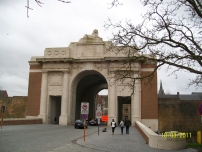| First Name: | Henry | Last Name: | LONG | |
|---|---|---|---|---|
| Date of Death: | 29/10/1914 | Lived/Born In: | Spitalfields | |
| Rank: | Private | Unit: | Gloucestershire1 | |
| Memorial Site: | Menin Gate, Ypres | |||
Current Information:Age-35 Enlisted-Dalston
First Battle of Ypres Between 21st October and 22nd November, 1914 a desperate fight took place around the Belgium city of Ypres, the first of three major battles that were to be fought there during the course of the war. British troops entered Ypres in October. The 1st and 2nd Divisions plus the 3rd Cavalry Division had made their way up from the Aisne as part of the “Race to the Sea”, whilst the 7th Division came west to Ypres after Antwerp had fallen. The Germans knew that Ypres was the gateway to the Channel ports and that these were vital to Britain’s war effort so they poured reinforcements into the area. The fighting fell into three distinct battles; the Battle of Langemarck, 21-24 October, the Battle of Gheluvelt, 29-31 October and the Battle of Nonne Bosschen, 11 November. Ypres did not fall to the Germans but its defence during these two months resulted in the destruction of much of the old regular British Army. Between 29th and 31st October a massive concentration of German troops tried to break the British line around Gheluvelt at the eastern apex of the Ypres salient. 1st and 7th Divisions stood in their path. At 5.30 am on 29th October and concealed by fog, the expected Germans attack began and fell on the Gheluvelt cross roads, where the Menin Road crossed between Kruiseecke and Poezelhoek. 1 Brigade, 1st Division held the line here and when these trenches were lost, the 1st Gloucestershire battalion of 3 Brigade, 1st Division were ordered to move up from Veldhoek and retake them. At 7 am three companies of 1st Gloucestershire moved up independently. One arrived 300 yards from the crossroads, rallied the survivors of the German attack but was then attacked itself from the north-east. A second company joined 1st Scots Guards and the third company pushed up between the other two and got into the firing line wherever they could. Later the fourth company moved up, found the first company in trouble and with it was forced back 300 yards after inflicting heavy casualties on the enemy. That evening after fighting hard throughout day, during which they suffered over 160 casualties one of whom was Henry Long, 1st Gloucestershire moved back to Veldhoek. |
||||
| « Back to Search Results | ||||
| If you think any of the information shown here is incorrect, Click Here to submit your amends and comments | ||||




